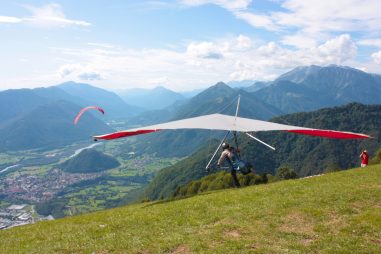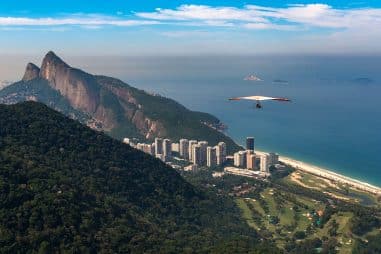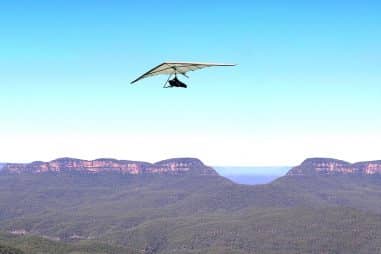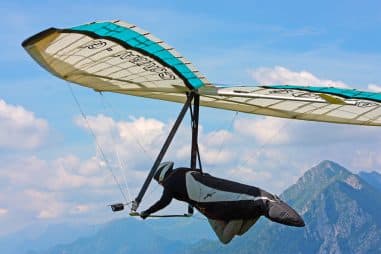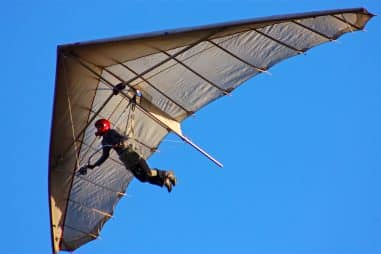Hang gliding is slowly getting popular among adrenaline junkies of all ages. The fact that you can actually fly is exhilarating and enthusiasts from all over the world flock to hang gliding meccas to experience this one-of-a-kind sport.
How Does a Hang Glider Work?
A hang glider is acted upon by three forces namely lift, drag and gravity. Lift is the upward force generated by the movement of the air over the surface of the wing. The drag is the force generated by the motion of the hang glider through the air. Gravity, which is affected by the combined weight of the pilot and the wing, is the force pulling the hang glider back to the ground.
Since regular hang gliders have no engine, a pilot has to take off from a place of elevation like the top of a mountain or a hill. You do this by running with the glider and getting to move the air across the wing between 24 to 40 kilometers per hour.
If you move fast enough, enough lift will be created by the wing and you will be successful in taking flight. Because the wing forms the shape of an aerofoil, it keeps the hang glider aloft.
To change directions or to do the desired turn, the pilot shifts their weight using the control bar. The control bar is also used to speed up, slow down, stall, and tip the nose down of your hang glider.
How Do Hang Gliders Stay in the Air for Hours?
In order for the hang glider to stay aloft for hours, it requires air movement. If the air is still, the hang glider will slowly lose altitude so you must find rising air to keep it aloft. A strong breeze will not only help the hang glider go higher but will also keep it flying.
You must always be aware of the wind pattern, speed and direction, and other micrometeorological changes including the rising air that may either be the result of thermal lift or ridge lift.
How Long Can Hang Gliders Stay in the Air?
This often depends on the skill level of the pilot. A pilot that has intermediate skill can stay in the air for several hours. On the other hand, advanced pilots can fly many miles if they choose to fly cross-country (XC).
It’s possible for hang gliders to stay in the air for long periods even without a motor. This is because their flight is sustained by the lift caused by the upwardly moving air.
What Is the Longest Time Anybody Has Remained in the Air on a Hang Glider?
While there is no record holder of the longest time a pilot has remained in the air, Dustin B. Martin’s time in 2012 is as impressive as it’s gonna get. During the World Record Encampment done in Texas, Martin flew for a total of 11 hours from Zapata to Lubbock.
He attributed this feat to the perfect wind condition in Zapata. The place is known as a perfect hang gliding spot due to the wind passing in the area.
How Far Can a Hang Glider Fly?
The distance that a hang glider covers depends on a lot of different aspects. During the summer months in the western states in the United States, some pilots can fly for over 100 miles before having to land.
Impressive records have been recorded in the past. These include flights that have traveled over 300 miles before landing.
What Is the Longest Hang Glider Flight?
In July 2012, pilot Dustin B. Martin set the world record for straight distance after he was able to fly 764 kilometers or 475 miles in Zapata, Texas. He flew his record-holder flight during the World Record Encampment in the hang gliding mecca of Central Texas.
His record flight took 11 hours and it clocked at an average speed of 69 kilometers per hour (kph). During the flight, the winds were around 20 to 30 miles per hour (mph), blowing in the south southeast direction.
Zapata is known as the place where hang gliders set world records. This is because the wind in this location blow in a straight line for long distances making it what enthusiasts call a hang gliding paradise.
How High Can a Hang Glider Go?
Like distance, there are several conditions at play when we are talking about the height that a hang glider can reach. While most flights can go as high as 1,350 to 1,800 meters or 4,000 to 6,000 feet, there were recorded flights to have reached over 17,999 feet above mean sea level (MSL).
17,999 feet MSL is the limitation that one can go. Going any higher than 3,000 to 4,000 meters or 9,800 to 13,000 can prove detrimental to the pilot as you would need oxygen when you reach that height.
Can Hang Gliders Go Up?
Hang gliders gain altitude with the help of “lift” or the air moving upwards. Hang gliders use either ridge lift or thermal lift.
Ridge lift sustains and helps increases altitude due to the rising air deflected by a ridge or a mountain. On the other hand, thermal lift happens due to the rising air created by the heat of the sun.
How Fast Can a Hang Glider Fly?
Hang gliders can go as fast as 120 kilometers per hour (kph) in a belly flight or when you ride it face down. Some professionals can even get to this speed even if they only flew a few meters above the ground.
If you go any faster, this should be cause for concern as there may be other forces controlling the speed. You should always work to be flying at a speed that is easy for you to control and maneuver.


